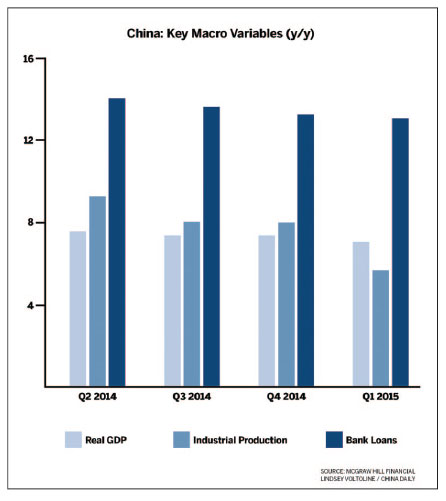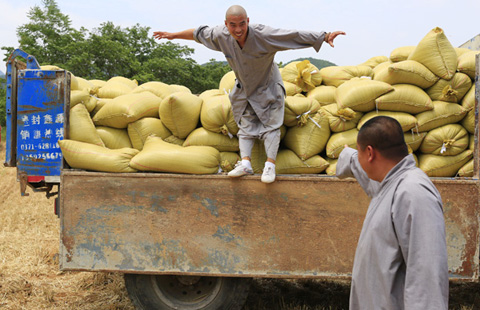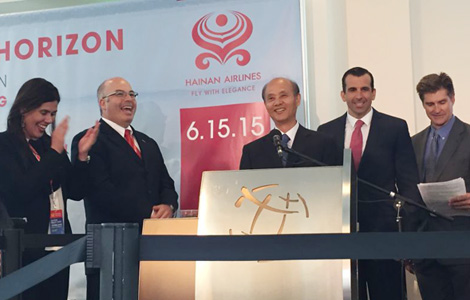'Positive moves' in China: S&P
Updated: 2015-06-16 11:27
By Dong Leshuo in Washington(China Daily USA)
|
||||||||
Shoring up local government debt is lowering the risks of a downside in China's economy, an expert said.
Paul Gruenwald, Standard & Poor's chief economist for the Asia-Pacific region, discussed general economic outlook for the APEC region and China's economic development at the Foreign Press Center in New York on Monday.
Growth and spending are likely to remain weak in Asia Pacific until the US recovery gains more traction and Chinese growth stabilizes, according to the research done by Standard & Poor's, he said.
Two issues are most important, by far, he said: One is the US. How the recovery is going and when does the Fed start to raise interest rates?
A close number two is risk: What's going on in mainland China? How's the property correction going? What's the short-term outlook for Chinese growth?
"We think the risks of a downside in China have actually fallen over the last couple of months. That's because the authorities are being more aggressive in trying to make sure that the local government financing is more solid," Gruenwald said.
For example, Gruenwald thinks the local government debt restructuring in China is "a very positive move".

"We think the short-term risks in China have actually fallen over the last couple of quarters," Gruenwald said.
Gruenwald thinks that's the biggest challenge over the next couple of years for China is to digest some of the excess supply in the property market, the steel market, the solar energy market and all the other industries and get through to a more sustainable economic path.
Regarding US-China economic relations, Gruenwald thinks the "US is still China's biggest trading partner. It's a very important bilateral relationship."
Gruenwald argues that there are clearly some two-way flows in the trade relationship between China and the US and it's not really the dollar amounts that are involved.
"When China or any other country sort of opens up to the rest of the world, they don't just trade the goods; they kind of trade the best practices and some of these other kinds of soft things that can be imported as well," he said.
"We want to make sure the playing field is level. We want to make sure we have as many industries involved as possible," Gruenwald said.
"I think if it's properly constructed with safeguards, then I think both countries benefit," Gruenwald said.
According to Gruenwald, two things that should be helping Asian growth right now but are not really showing from the data is the US recovery and oil prices.
"Before the crisis, countries in Asia were getting 1-to-2 percent of their growth in from external demand. That disappeared from the crisis and never came back," he said.
"This is kind of a mystery because we expect the US recovery will help with exports in Asia."
However, the US recovery is not translating into higher trade, GDP growth in the Asia-Pacific region, according to S&P research.
"Another thing that should be helping Asia growth and we really haven't seen it so far is oil prices," Gruenwald said.
Oil prices dropped sharply in the second half of 2014. However, it has had little effect on the APAC data.
leshuodong@chinadailyusa.com

 Ten photos you don't wanna miss - June 16
Ten photos you don't wanna miss - June 16
 Shaolin monks harvest bumper crop
Shaolin monks harvest bumper crop
 Cambridge students mark end of exam with boat race
Cambridge students mark end of exam with boat race
 Village attracts tourists after first lady's visit
Village attracts tourists after first lady's visit
 Top 9 US-listed Chinese companies going private
Top 9 US-listed Chinese companies going private
 Hainan San Jose to Beijing: Ready for take-off
Hainan San Jose to Beijing: Ready for take-off
 Trending Across China: A Porsche gilded in gold
Trending Across China: A Porsche gilded in gold
 Paris Air Show: From Bombardier's new C Series to China Airlines
Paris Air Show: From Bombardier's new C Series to China Airlines
Most Viewed
Editor's Picks

|

|

|

|

|

|
Today's Top News
Jeb Bush announces bid for 2016 Republican presidential run
China, US develop new MERS treatment
China to complete land reclamation of construction on some Nansha Islands soon
Military launches drive to root out corruption in construction projects
Key China-US talks next week
China, US sign agreement to boost army cooperation
City honors slain NYPD
Detective Liu
Chinese students on trial in alleged torture of peer
US Weekly

|

|







